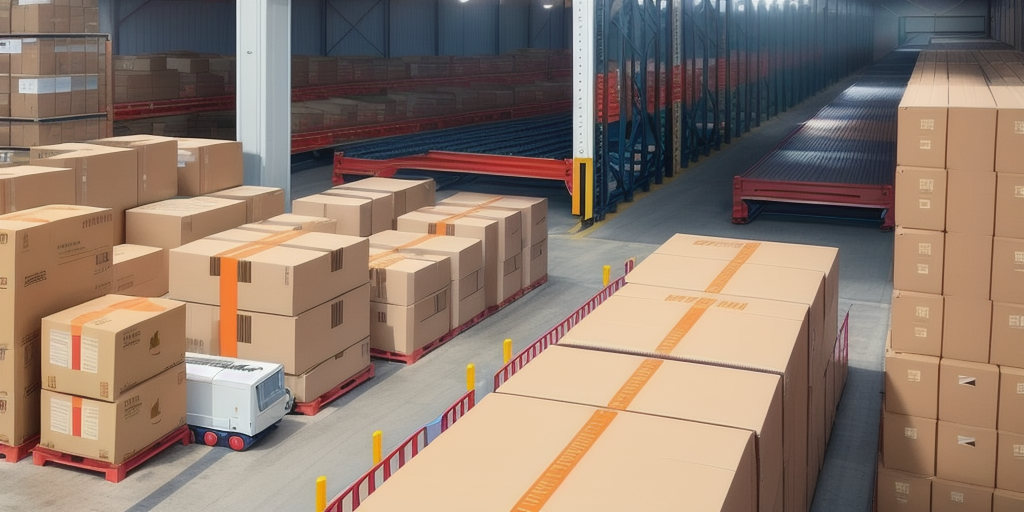Understanding the Benefits of EXW (Ex Works) in Supply Chain Management
In today's global economy, supply chain management is a critical component of any successful business. One significant factor in supply chain management is the mode of delivery used to transport goods from the supplier to the customer. One of these options is Ex Works, commonly known as EXW. EXW can provide substantial benefits for businesses looking to optimize their supply chain. In this article, we will explore what EXW is, its advantages and disadvantages, how to implement it, and the risks and challenges involved, among other topics.
What is EXW and How Does It Work?
EXW, or Ex Works, is a term defined by the International Chamber of Commerce's Incoterms, which sets standardized terms used globally to govern international trade. EXW specifies that the seller delivers the goods at their premises or another agreed-upon location. This term is primarily used for goods transported by land or sea.
Under EXW, the customer is responsible for all transportation, export clearance, and import clearance processes and costs. Essentially, the seller's responsibility ends once the goods are made available to the buyer's transport carrier. While EXW may seem cost-effective for buyers, it comes with risks such as unexpected costs or delays if the buyer is unfamiliar with the regulations and procedures of the exporting and importing countries. Additionally, if the goods are damaged or lost during transportation, the buyer may face challenges in seeking compensation from the seller. Therefore, clear understanding and effective communication between both parties are crucial for a smooth transaction.
The Role of EXW in International Trade
EXW is a commonly used delivery term in international trade because it provides buyers with the flexibility to plan and organize the transportation of goods according to their specific needs. This flexibility allows buyers to negotiate favorable transportation rates by choosing the mode of transportation and carrier that best suits their requirements. Additionally, since the buyer is responsible for insurance, EXW can be a cost-effective option for smaller businesses that may not afford the added expense of insurance.
However, it's important to note that with EXW, the seller's responsibility ceases once the goods are made available at their premises. This means the buyer bears all risks and costs associated with transporting goods from the seller's location to the final destination. Consequently, buyers must have a comprehensive understanding of the transportation process and ensure adequate insurance coverage to protect their goods during transit.
Advantages of Using EXW in Supply Chain Management
- Flexibility in Transportation: EXW allows buyers to choose their preferred mode of transportation and carrier, potentially lowering shipping costs and reducing delivery times.
- Simplified Import/Export Process: Buyers manage all import and export procedures, which can streamline the process, especially for those experienced in international logistics.
- Reduced Risk of Damage or Loss: By selecting reliable carriers, buyers can minimize the risk of goods being damaged or lost during transit.
- Enhanced Buyer-Seller Communication: The need for frequent communication to manage transportation and customs procedures can strengthen the relationship between buyer and seller, fostering greater trust and collaboration.
Disadvantages of Using EXW in Supply Chain Management
- Assumption of Risks: Buyers assume all risks associated with transportation, including potential damage or loss of goods during transit.
- Complex Import/Export Procedures: Managing all import and export procedures can add complexity and costs, particularly for those unfamiliar with customs regulations.
- Potential for Delays: Without the necessary resources or expertise, buyers may face delays in arranging transportation, impacting production schedules and customer satisfaction.
- Limited Negotiation Power: Buyers may have less bargaining power with suppliers since they are responsible for all transportation and customs procedures, potentially leading to higher overall costs.
How to Implement EXW in Your Supply Chain Strategy
Implementing EXW requires a thorough understanding of its requirements and associated risks. Here are some steps to effectively integrate EXW into your supply chain strategy:
- Collaborate with an Experienced Freight Forwarder: Partner with a freight forwarder experienced in handling EXW shipments to navigate transportation logistics efficiently.
- Clarify Responsibilities: Ensure both parties clearly understand their responsibilities under EXW terms to prevent misunderstandings and potential disputes.
- Develop a Comprehensive Contract: Outline the roles and responsibilities of each party in a detailed contract to provide clarity and legal protection.
- Secure Necessary Documentation: Obtain all required licenses, permits, and certificates for export and import procedures to facilitate smooth customs clearance.
- Choose Reliable Transport Carriers: Select transport carriers with a proven track record in handling EXW shipments to ensure the safe and timely delivery of goods.
Additionally, anticipate potential challenges such as customs clearance issues, transportation delays, and coordination difficulties. Establishing a contingency plan and maintaining regular communication with all parties involved can help mitigate these challenges.
Key Considerations When Using EXW in Supply Chain Management
- Cost-Effectiveness for Small Businesses: EXW can be a budget-friendly option for smaller businesses that may not have the resources to cover insurance and other transportation costs.
- Transportation Flexibility: The ability to select preferred transportation modes and carriers offers significant flexibility in managing shipments.
- Risk Management: Buyers must be prepared to manage all risks related to transportation, including potential damage or loss during transit.
- Complexity of Customs Procedures: Navigating customs procedures can be complex, especially for buyers unfamiliar with the destination country's regulations.
Case Studies: Successful Implementation of EXW in Supply Chain Management
Many companies have successfully integrated EXW into their supply chain strategies. For example, a company specializing in the export of agricultural products utilized EXW to negotiate favorable transportation rates with carriers, resulting in significant cost savings. By managing the entire import and export process, the company gained greater control over its supply chain, enhancing efficiency and reducing reliance on third parties.
Another case involves a manufacturing firm that adopted EXW to streamline its logistics operations. By selecting carriers with robust tracking systems, the firm reduced delivery times and improved customer satisfaction. These examples demonstrate how EXW can be leveraged to optimize supply chain management effectively.
Risks and Challenges Associated with EXW in Supply Chain Management
- Transportation Risks: Buyers assume the risk of damage or loss during transit, necessitating comprehensive insurance coverage.
- Complex Customs Procedures: Navigating the intricacies of customs regulations in the destination country can be challenging and time-consuming.
- Unexpected Costs: Buyers may encounter unforeseen expenses such as import duties, taxes, or processing fees, impacting overall profitability.
- Delays in Customs Clearing: Lack of experience in import/export procedures can lead to delays in customs clearance, disrupting supply chain timelines.
Alternatives to EXW for Efficient Supply Chain Management
While EXW offers various benefits, other delivery terms might better suit certain business needs. Alternatives include:
- Free on Board (FOB): The seller is responsible for delivering goods to the port of shipment and handling export clearance, while the buyer assumes responsibility once goods are on board the vessel.
- Cost, Insurance, and Freight (CIF): The seller covers the cost, insurance, and freight to transport goods to the destination port, providing more security for the buyer.
- Delivered Duty Paid (DDP): The seller manages all aspects of transportation, including import duties and taxes, delivering goods directly to the buyer's location.
Each of these delivery terms has its own set of advantages and disadvantages, and the optimal choice will depend on the specific requirements and capabilities of both the buyer and seller.
How to Negotiate Favorable Terms When Using EXW
- Engage an Experienced Freight Forwarder: A knowledgeable freight forwarder can assist in negotiating competitive transportation rates and managing the complexities of the export and import process.
- Develop a Clear Contract: A well-defined contract outlining each party's responsibilities can prevent misunderstandings and ensure smooth operations.
- Ensure Proper Documentation: Secure all necessary licenses, permits, and certificates to facilitate seamless export and import procedures.
- Select Reliable Transport Carriers: Working with reputable carriers experienced in handling EXW shipments can enhance the reliability and efficiency of your supply chain.
Using Technology to Optimize Your Use of EXW in Supply Chain Management
Leveraging technology can significantly optimize the use of EXW in supply chain management. Key technological tools include:
- Supply Chain Management Software: Utilize software solutions to manage export and import processes, track shipments, and streamline logistics operations.
- Tracking and Traceability Systems: Implement tracking systems to monitor the real-time progress of shipments, ensuring transparency and timely updates.
- Data Analytics: Analyze data to identify inefficiencies, forecast demand, and make informed decisions to improve supply chain performance.
Integrating these technologies can enhance visibility, improve decision-making, and increase overall supply chain efficiency.
Common Mistakes to Avoid When Using EXW in Supply Chain Management
- Misunderstanding Responsibilities: Failing to fully comprehend the buyer's responsibilities under EXW can lead to logistical challenges and increased costs.
- Working with Inexperienced Partners: Collaborating with freight forwarders or carriers lacking experience in EXW shipments can result in delays and mishandling of goods.
- Incomplete Documentation: Missing or inaccurate export/import documentation can cause significant delays and penalties at customs.
- Poor Process Management: Inefficiently managing the export and import processes can disrupt the supply chain and impact business operations.
Future Trends and Developments in the Use of EXW in Global Supply Chains
The utilization of EXW in global supply chains is anticipated to continue evolving. Key future trends include:
- Increased Globalization: As businesses expand internationally, the demand for flexible and cost-effective delivery terms like EXW is expected to grow.
- Technological Advancements: Continued advancements in supply chain technology will enhance the efficiency and reliability of EXW transactions, offering better tracking, automation, and data integration.
- Sustainability Initiatives: Businesses may adopt sustainable practices within EXW terms, such as selecting eco-friendly carriers and optimizing routes to reduce carbon footprints.
These trends highlight the ongoing adaptability and relevance of EXW in the dynamic landscape of global supply chain management.
Conclusion: Is EXW the Right Choice for Your Business?
Choosing the appropriate delivery term is crucial for effective supply chain management. While EXW offers significant benefits such as flexibility and cost-effectiveness, it also requires buyers to assume substantial responsibilities and risks. Carefully weighing the advantages and disadvantages, considering your business's specific needs, and collaborating with experienced partners can help determine if EXW is the right choice for your business. Proper implementation and management of EXW terms can lead to a streamlined supply chain, enhanced relationships with suppliers, and improved overall business performance.






















